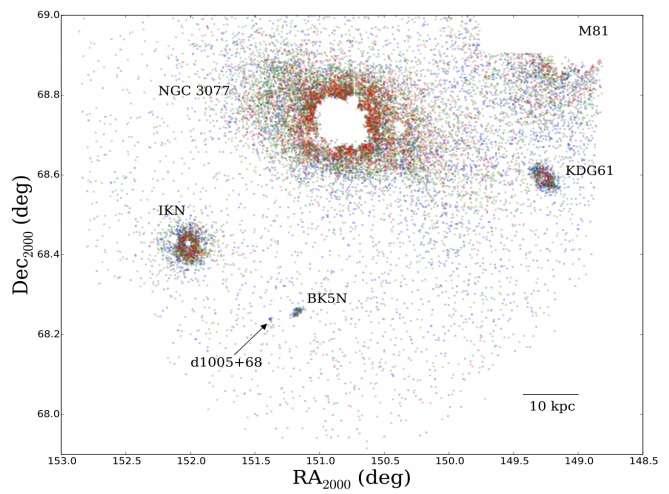July 3, 2017 report
New faint dwarf galaxy discovered

(Phys.org)—Astronomers have detected a new faint dwarf spheroidal galaxy using Japan's Subaru Telescope located in Hawaii. The newly found dwarf, designated d1005+68, belongs to a nearby galaxy group known as the M81 Group. The new findings were presented June 22 in a paper published on the arXiv pre-print repository.
Dwarf galaxies are small galaxies composed of about 100 million up to several billion stars. Astronomers are puzzled by the so-called "dwarf galaxy problem" (also known as the missing satellites problem), arising from simulations predicting the evolution of the distribution of matter in the universe. Dark matter simulations show that the number of dwarf galaxies should be orders of magnitude higher than actually observed.
To resolve this conundrum, scientists are searching for these missing dwarfs, especially beyond the Local Group of galaxies. Currently available surveys enable identification of faint dwarfs in nearby galaxy groups, and recently, a team of astronomers led by Adam Smercina of the University of Michigan has detected such a new faint dwarf in the M81 Group – one of the groups nearest to the Local Group.
The researchers used the Hyper Suprime-Cam (HSC) installed on the Subaru Telescope to conduct a survey of M81's resolved stellar halo. The HSC camera allowed the team to distinguish an overdensity of stars, which turned out to be a faint dwarf spheroidal galaxy.
"In this Letter, we presented a new faint dwarf galaxy, d1005+68, with properties consistent with being a satellite of the M81 Group. It was detected as a 5σ overdensity in our 3.5 deg2 Subaru Hyper Suprime-Cam survey of M81's resolved stellar halo," the astronomers wrote in the paper.
The study reveals that d1005+68 is located some 13 million light years from the Earth and approximately 250,000 light years from the M81 galaxy. The dwarf has a half-light radius of 613 light years and an estimated stellar mass of about 250,000 solar masses. The researchers assume that the galaxy is about 12 billion years old.
With an absolute V-band magnitude of 7.94, d1005+68 is one of the faintest confirmed galaxies discovered outside of the Local Group.
What still puzzles the scientists is the proximity of d1005+68 to the dwarf elliptical galaxy designated BK5N – a satellite of M81. According to the paper, they are separated from each other by about 16,300 light years, which suggests that d1005+68 could be a satellite of BK5N.
"The projected separation between d1005+68 and BK5N of 5 kpc is well within the estimated virial radius of BK5N (about 40 kpc). With our highly uncertain TRGB (tip of the red-giant branch) distance (due to scarcity of stars) and the similarity between the two CMDs (color-magnitude diagrams), this introduces the possibility that d1005+68 is a satellite of BK5N," the team wrote.
However, more observations that could provide more accurate distance estimates and line of sight velocity information are needed in order to prove this hypothesis is true. If confirmed, d1005+68 would be the first satellite-of-a-satellite discovered outside of the Local Group.
More information: d1005+68: A New Faint Dwarf Galaxy in the M81 Group, arXiv:1706.07039 [astro-ph.GA] arxiv.org/abs/1706.07039
Abstract
We present the discovery of d1005+68, a new faint dwarf galaxy in the M81 Group, using observations taken with the Subaru Hyper Suprime-Cam. d1005+68's color-magnitude diagram is consistent with a distance of 3.98+0.39−0.43 Mpc, establishing group membership. We derive an absolute V-band magnitude, from stellar isochrone fitting, of MV=−7.94+0.38−0.50, with a half-light radius of rh=188+39−41 pc. These place d1005+68 within the radius-luminosity locus of Local Group and M81 satellites and among the faintest confirmed satellites outside the Local Group. Assuming an age of 12 Gyr, d1005+68's red giant branch is best fit by an isochrone of [Fe/H] =−1.90±0.24. It has a projected separation from nearby M81 satellite BK5N of only 5 kpc. As this is well within BK5N's virial radius, we speculate that d1005+68 may be a satellite of BK5N. If confirmed, this would make d1005+68 one of the first detected satellites-of-a-satellite.
© 2017 Phys.org



















